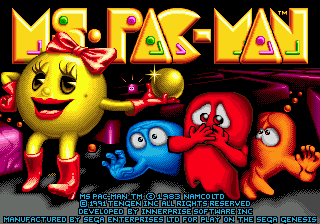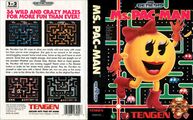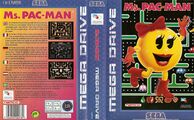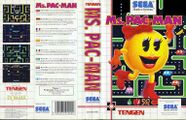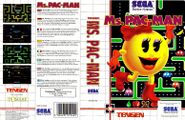Difference between revisions of "Ms. Pac-Man"
From Sega Retro
m |
|||
| Line 5: | Line 5: | ||
| system=[[Sega Mega Drive]], [[Sega Master System]], [[Sega Game Gear]] | | system=[[Sega Mega Drive]], [[Sega Master System]], [[Sega Game Gear]] | ||
| usa={{MD}} 1991 {{GG}} 1995 | | usa={{MD}} 1991 {{GG}} 1995 | ||
| − | | europe={{SMS}} 1991 {{MD}} | + | | europe={{SMS}} 1991 {{MD}} 1995 |
| genre=Action | | genre=Action | ||
| romsize={{MD}}+{{SMS}} 128KB | | romsize={{MD}}+{{SMS}} 128KB | ||
Revision as of 16:28, 27 March 2011
| Ms. Pac-Man |
|---|
| System(s): Sega Mega Drive, Sega Master System, Sega Game Gear |
| Publisher: Tengen (US), Time Warner Interactive (EU) Tengen Majesco Games |
| Developer: Innerprise Software Tengen Namco |
| Genre: Action |
Ms. Pac-Man is a 1981 arcade game developed by Midway as an unlicensed modification of the original Pac-Man before being taken by Namco as an official game. Its success has spawned many ports, including Tengen's 1991 ports to the Sega Mega Drive, Sega Master System and Sega Game Gear. The Game Gear version is a direct port, while the Master System and Mega Drive versions are enhanced.
Although it is virtually identical to the SNES game of the same name, the Mega Drive version is more difficult as Ms. Pac-Man does not respond to joystick presses as well as the SNES game does. The Master System and Game Gear versions do not have this problem.
Contents
Gameplay
Players move through a maze gobbling up dots while avoiding ghosts. If a big dot (power pellet) is eaten by the player ghosts become eatable and if eaten their eyes depart from the body and flee to the center of the maze, where they can claim a new body. Occasionally fruit and other objects float through the maze and give bonus points if eaten.
On the Mega Drive and Master System versions there are many new extras. There are four types of mazes: Arcade, Strange, Big, and Mini. A Pac Booster ability can be turned on and off, which gives the player a boost when pressing a button. There is also two-player simultaneous feature in which the first player will play Ms. Pac-Man and the second will play the original Pac-Man. This can be done in cooperative or competitive modes. The game also would end at level 32 in which a game ending would be displayed. The "fruit" selection is also expanded and objects such as shoes could be eaten for greater points than fruit in the arcade version.
Credits
Programmer: Stephane Leblanc
Graphics: Mike Bazzell
Music/Sounds: Earl Vickers
Sound Driver: Lisa Ching
Physical Scans
| Sega Retro Average | ||||
|---|---|---|---|---|
|
| {{|L}} | N/A |
|---|---|
| Based on 0 reviews | |
Mega Drive Version
Master System Version
Game Gear Version
| Pac-Man games for Sega systems | |
|---|---|
| Pac-Man (1991) | Ms. Pac-Man (1993) | Pac-Attack (1994) | Pac-In-Time (unreleased) | |
| Ms. Pac-Man (1991) | Pac-Mania (1991) | |
| Ms. Pac-Man (1991) | Pac-Mania (1991) | Pac-Attack (1993) | Pac-Man 2: The New Adventures (1994) | Pac-In-Time (unreleased) | |
| Ms. Pac-Man Maze Madness (2000) | |
- No players field
- Old content rating field
- Use romtable template
- All games
- Old-style rating (consolesplus)
- Rating without source
- Old-style rating (gameplayers)
- Old-style rating (hobbyconsolas)
- Old-style rating (mm)
- Old-style rating (joypad)
- Old-style rating (playerone)
- Old-style rating (pp)
- Old-style rating (sfuk)
- No ratings
- Pac-Man (franchise)
- 1991 Mega Drive Games
- Mega Drive Games
- Mega Drive Action Games
- 1991 Master System Games
- Master System Games
- Master System Action Games
- 1995 Game Gear Games
- Game Gear Games
- Game Gear Action Games
